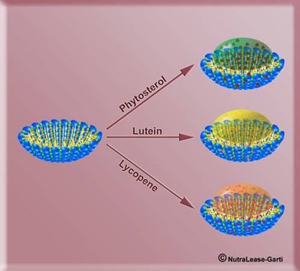
|
|
|
Research Activities

Research Activities- "Interfacial phenomena in dispersed liquids"
a) Summary
- Surfactant chemistry
- Crystallization phenomena and polymorphism of fats, cocoa butter, fatty acids, cholesterol and phytosterols and lipids
- Liquid dispersed systems - Emulsions, microemulsions, double emulsions, emulsified microemulsions,
- Novel nanosized self-assembled liquid vehicles (NSSL technology)
- Novel lyotropic liquid crystals (QL and micellosomes) as solubilization vehicles for improved solubilization capacities of non-soluble bioactives and bioavailability
- Transdermal and transmembrane competitive transport via nano-vehicles
- Nutraceuticals and food supplements- structure, mechanisms and bioavailability
- Regioselectivity and Interfacial Reactions (enzymatic and chemical)
- Food chemistry with emphasis on fats, oils, fatty acids, lipids
- Hydrocolloids and proteins as amphiphiles - Extraction, enzymatic modification, hybridization, structure and reactivity.
- Development of new and advanced analytical tools for studying structural aspects of nanosized systems such as SAXS, SD-NMR, Cryo-TEM, Dielectric Spectroscopy, DSC, rheology, EPR, TDS, etc.
- Alternative and new synthesis of surfactants and bio amphiphiles
b) The group is organized into subunits with various competences in the areas of:
- Synthetic organic chemistry of surfactants
- Physical chemistry, surface and colloid science, emulsion technology, crystallization phenomena, extraction processes
- Nutraceuticals - extraction, characterization, solubilization and bioavailability of molecules from natural sources with health benefits
- Drug Delivery vehicles- Nanosized Self-assembled Liquid (NSSL) vehicles
- Lyotropic Liquid Crystals (LLC) - Formation, structure studies, solubilization and transformations of cubosomes, hexosomes
- Novel liquid micellar discontinuous phases- the QL phase.
- Bioavailability of nutraceuticals and drugs
- Competitive adsorption (cholesterol and phytosterols)
c) More specifically the group is involved in the following activities:
- Search for new or modified nanosized self-assembled liquid (NSSL) vehicles by controlling geometries, curvatures, interfacial tensions, etc.
- Solubilize and orient reactants and precursors for making specific and regioselective organic (signature flavoring and aroma molecules) and enzymatic (phospholipids, monoglycerides) products.
- Using nanodroplets as nano-reactors for crystallization processes yielding new polymorphic crystals (drugs, sweeteners, nutraceuticals).
- Solubilization of insoluble active molecules (drugs and nutraceuticals) and use the nano-vehicles to transport the guest molecules to food products and via the digestive tracts to the blood stream.
- Competitive solubilization of bioactives at interfaces of microemulsions.
- Stabilization (physically or chemically) of sensitive molecules against oxidation in dispersed systems (i.e. lycopene, lutein, tocopherols).
- Control the release of active molecules from the core of the dispersed system (microemulsion, microcapsule) to the outer continuous interface.
- Design new emulsifiers and to prepare new products with significant commercial and scientific advantages.
- Modify proteins and hydrocolloids to form nanosized aggregates.
- Prepare emulsified microemulsions (modified double emulsions) for improved solubilization and control the release of entrapped matter.
- Food emulsions and interfacial modifications.
- Nutraceuticals - solubilization and characterization.
- Novel double emulsions – Emulsified microemulsions (EME).
- Transdermal transport of drugs and dermal penetration of bioactives.
- Transmembrane drug delivery of insoluble drugs.
|
|
|
|